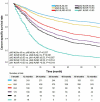The Effect of Examined Lymph Nodes and Lymph Node Ratio on Pathological Nodal Classification in the Lung Adenosquamous Carcinoma After Lobectomy
- PMID: 35756483
- PMCID: PMC9218197
- DOI: 10.3389/fsurg.2022.909810
The Effect of Examined Lymph Nodes and Lymph Node Ratio on Pathological Nodal Classification in the Lung Adenosquamous Carcinoma After Lobectomy
Abstract
Objective: The effects of examined lymph nodes (LNs) and lymph node ratio (LNR) on pN classification and the prognosis are unclear in lung adenosquamous carcinoma (ASC) patients. Thus, this study aimed to investigate the significance of LNs and LNR in the prognosis of ASC and the impact of the abovementioned factors on the pN classification.
Methods: Patients diagnosed with pathological stage T1-4N0-2M0 ASC from the Surveillance Epidemiology and End Results database were included in the study. The primary clinical endpoint was cancer-specific survival (CSS). The optimal cutoff values of the LNs and LNR were determined. An LN indicator, including pN0 #LNs ≤9, pN0 #LNs >9, pN+ #LNR ≤0.53, and pN+ #LNR > 0.53, was developed. Concordance index (C-index) was used to compare the prognostic predictive ability between N classification and LN indicator. The univariable and multivariable Cox regression analyses were used in this study.
Results: The cohort of 1,416 patients were included in the study. The level of LNs stratified the patients without metastasis of lymph nodes (pN0 #LNs ≤9 vs. pN0 #LNs >9, unadjusted hazard ratio [HR] = 1.255, P = 0.037). Two groups based on the cutoff value of LNR differentiated prognosis of patients with metastasis of lymph nodes (pN+ #LNR >0.53 vs. pN+ #LNR ≤0.53, unadjusted HR = 1.703, P = 0.001). The LN indicator had a much better predictive ability over N classification in this cohort (LN indicator: C-index = 0.615; N classification: C-index = 0.602, P = 0.001).
Conclusions: We explored clinicopathological factors affecting prognosis in resected lung ASC patients. Besides, the LN indicator was confirmed to be played an essential role in affecting the survival rate in ASC patients. The high-level LNs or low-level LNR might be corelated to improved survival outcomes.
Keywords: adenosquamous carcinoma; lymph node; lymph node ratio; non-small cell lung cancer; survival.
Copyright © 2022 Feng, Liu, Huang, Shi and Zhang.
Conflict of interest statement
The authors declare that the research was conducted in the absence of any commercial or financial relationships that could be construed as a potential conflict of interest.
Figures





Similar articles
-
Reconsidering N component of cancer staging for T1-2N0-2M0 small-cell lung cancer: a retrospective study based on multicenter cohort.Respir Res. 2023 Jun 23;24(1):168. doi: 10.1186/s12931-023-02440-3. Respir Res. 2023. PMID: 37353782 Free PMC article.
-
Revolutionizing T3-4N0-2M0 gastric cancer staging with an innovative pathologic N classification system.J Gastrointest Surg. 2024 Aug;28(8):1283-1293. doi: 10.1016/j.gassur.2024.05.031. Epub 2024 May 29. J Gastrointest Surg. 2024. PMID: 38821213
-
A Proposal for Combination of Lymph Node Ratio and Anatomic Location of Involved Lymph Nodes for Nodal Classification in Non-Small Cell Lung Cancer.J Thorac Oncol. 2016 Sep;11(9):1565-73. doi: 10.1016/j.jtho.2016.05.004. Epub 2016 May 17. J Thorac Oncol. 2016. PMID: 27223457
-
Ratio and log odds of positive lymph nodes in breast cancer patients with mastectomy.Surg Oncol. 2015 Sep;24(3):239-47. doi: 10.1016/j.suronc.2015.05.001. Epub 2015 May 19. Surg Oncol. 2015. PMID: 26055316 Review.
-
Prognostic Value of Lymph Node Ratio in Cutaneous Melanoma: A Systematic Review.Cureus. 2021 Oct 29;13(10):e19117. doi: 10.7759/cureus.19117. eCollection 2021 Oct. Cureus. 2021. PMID: 34868763 Free PMC article. Review.
Cited by
-
Role of Postoperative Radiotherapy on High-Risk Stage pIIIA-N2 Non-Small Cell Lung Cancer Patients After Complete Resection and Adjuvant Chemotherapy: A Retrospective Cohort Study.World J Oncol. 2024 Apr;15(2):309-318. doi: 10.14740/wjon1832. Epub 2024 Mar 21. World J Oncol. 2024. PMID: 38545478 Free PMC article.
References
LinkOut - more resources
Full Text Sources
Miscellaneous

